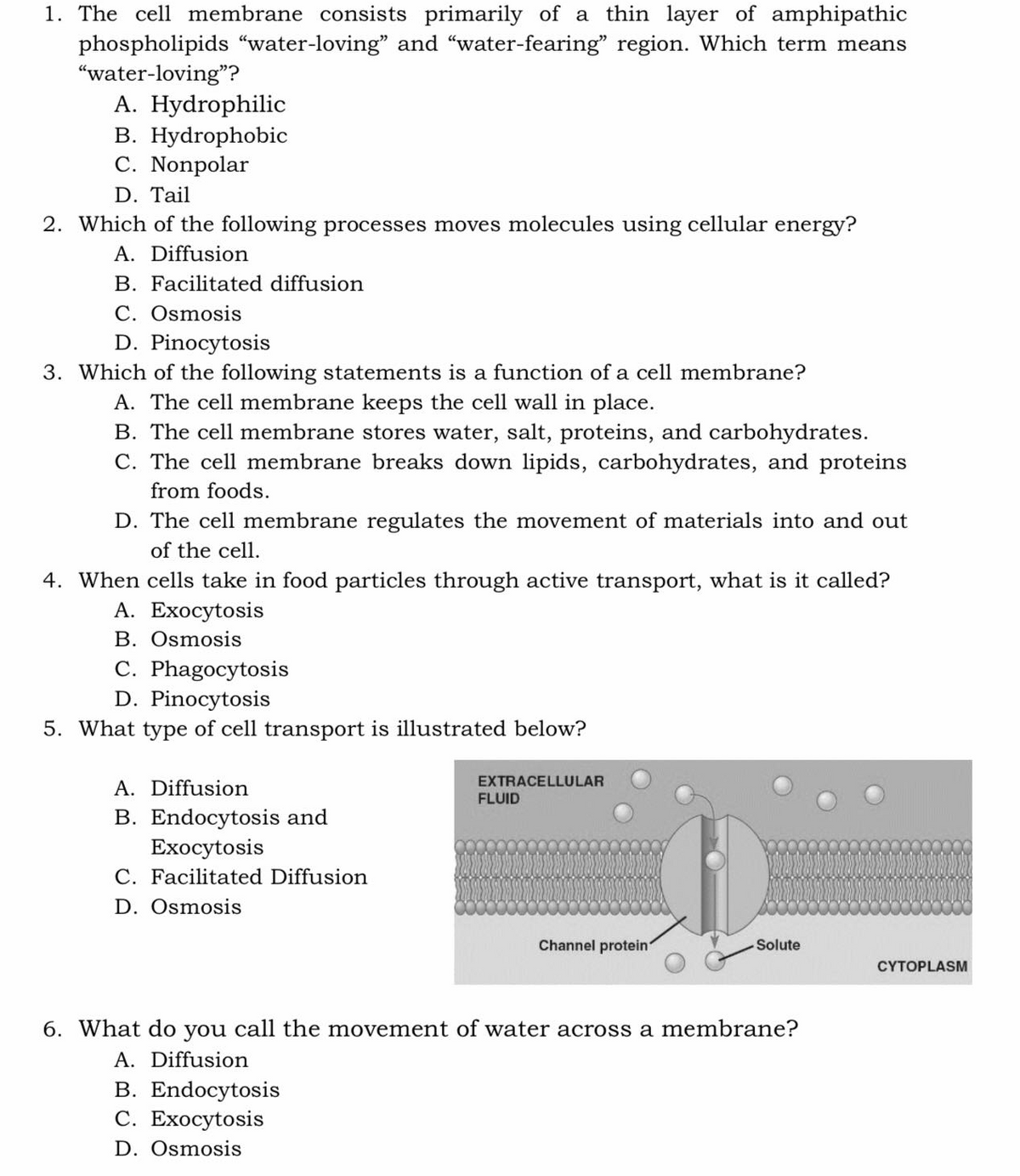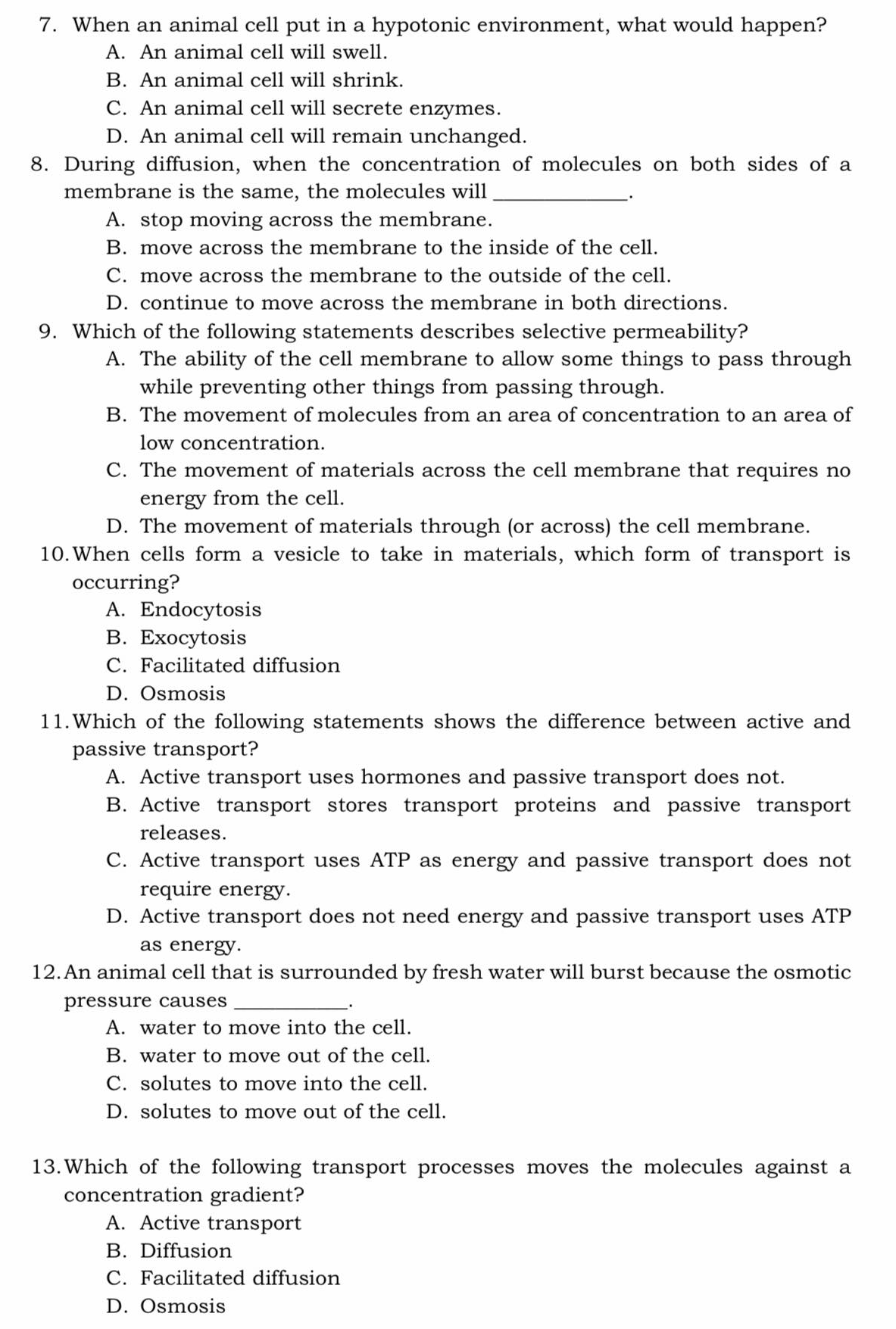1. The cell membrane consists primarily of a thin layer of amphipathic phospholipids "water-loving" and "water-fearing" region. Which term means "water-loving"? A. Hydrophilic B. Hydrophobic C. Nonpolar D. Tail 2. Which of the following processes moves molecules using cellular energy? A. Diffusion B. Facilitated diffusion C. Osmosis D. Pinocytosis 3. Which of the following statements is a function of a cell membrane? A. The cell membrane keeps the cell wall in place. B. The cell membrane stores water, salt, proteins, and carbohydrates. C. The cell membrane breaks down lipids, carbohydrates, and proteins from foods. D. The cell membrane regulates the movement of materials into and out of the cell. 4. When cells take in food particles through active transport, what is it called? А. Ехосytosis B. Osmosis C. Phagocytosis D. Pinocytosis
1. The cell membrane consists primarily of a thin layer of amphipathic phospholipids "water-loving" and "water-fearing" region. Which term means "water-loving"? A. Hydrophilic B. Hydrophobic C. Nonpolar D. Tail 2. Which of the following processes moves molecules using cellular energy? A. Diffusion B. Facilitated diffusion C. Osmosis D. Pinocytosis 3. Which of the following statements is a function of a cell membrane? A. The cell membrane keeps the cell wall in place. B. The cell membrane stores water, salt, proteins, and carbohydrates. C. The cell membrane breaks down lipids, carbohydrates, and proteins from foods. D. The cell membrane regulates the movement of materials into and out of the cell. 4. When cells take in food particles through active transport, what is it called? А. Ехосytosis B. Osmosis C. Phagocytosis D. Pinocytosis
Biology: The Dynamic Science (MindTap Course List)
4th Edition
ISBN:9781305389892
Author:Peter J. Russell, Paul E. Hertz, Beverly McMillan
Publisher:Peter J. Russell, Paul E. Hertz, Beverly McMillan
Chapter5: Membranes And Transport
Section: Chapter Questions
Problem 3TYK: The freeze-fracture technique demonstrated: a. that the plasma membrane is a bilayer with individual...
Related questions
Question

Transcribed Image Text:1. The cell membrane consists primarily of a thin layer of amphipathic
phospholipids "water-loving" and "water-fearing" region. Which term means
"water-loving"?
A. Hydrophilic
B. Hydrophobic
C. Nonpolar
D. Tail
2. Which of the following processes moves molecules using cellular energy?
A. Diffusion
B. Facilitated diffusion
C. Osmosis
D. Pinocytosis
3. Which of the following statements is a function of a cell membrane?
A. The cell membrane keeps the cell wall in place.
B. The cell membrane stores water, salt, proteins, and carbohydrates.
C. The cell membrane breaks down lipids, carbohydrates, and proteins
from foods.
D. The cell membrane regulates the movement of materials into and out
of the cell.
4. When cells take in food particles through active transport, what is it called?
А. Ехоcytosis
B. Osmosis
C. Phagocytosis
D. Pinocytosis
5. What type of cell transport is illustrated below?
EXTRACELLULAR
A. Diffusion
FLUID
B. Endocytosis and
Exocytosis
C. Facilitated Diffusion
D. Osmosis
Channel protein
Solute
CYTOPLASM
6. What do you call the movement of water across a membrane?
A. Diffusion
B. Endocytosis
С. Ехосytosis
D. Osmosis

Transcribed Image Text:7. When an animal cell put in a hypotonic environment, what would happen?
A. An animal cell will swell.
B. An animal cell will shrink.
C. An animal cell will secrete enzymes.
D. An animal cell will remain unchanged.
8. During diffusion, when the concentration of molecules on both sides of a
membrane is the same, the molecules will
A. stop moving across the membrane.
B. move across the membrane to the inside of the cell.
C. move across the membrane to the outside of the cell.
D. continue to move across the membrane in both directions.
9. Which of the following statements describes selective permeability?
A. The ability of the cell membrane to allow some things to pass through
while preventing other things from passing through.
B. The movement of molecules from an area of concentration to an area of
low concentration.
C. The movement of materials across the cell membrane that requires no
energy from the cell.
D. The movement of materials through (or across) the cell membrane.
10. When cells form a vesicle to take in materials, which form of transport is
occurring?
A. Endocytosis
В. Ехосytosis
C. Facilitated diffusion
D. Osmosis
11.Which of the following statements shows the difference between active and
passive transport?
A. Active transport uses hormones and passive transport does not.
B. Active transport stores transport proteins and passive transport
releases.
C. Active transport uses ATP as energy and passive transport does not
require energy.
D. Active transport does not need energy and passive transport uses ATP
as energy.
12. An animal cell that is surrounded by fresh water will burst because the osmotic
pressure causes
A. water to move into the cell.
B. water to move out of the cell.
C. solutes to move into the cell.
D. solutes to move out of the cell.
13. Which of the following transport processes moves the molecules against a
concentration gradient?
A. Active transport
B. Diffusion
C. Facilitated diffusion
D. Osmosis
Expert Solution
This question has been solved!
Explore an expertly crafted, step-by-step solution for a thorough understanding of key concepts.
This is a popular solution!
Trending now
This is a popular solution!
Step by step
Solved in 10 steps

Knowledge Booster
Learn more about
Need a deep-dive on the concept behind this application? Look no further. Learn more about this topic, biology and related others by exploring similar questions and additional content below.Recommended textbooks for you

Biology: The Dynamic Science (MindTap Course List)
Biology
ISBN:
9781305389892
Author:
Peter J. Russell, Paul E. Hertz, Beverly McMillan
Publisher:
Cengage Learning

Human Physiology: From Cells to Systems (MindTap …
Biology
ISBN:
9781285866932
Author:
Lauralee Sherwood
Publisher:
Cengage Learning

Anatomy & Physiology
Biology
ISBN:
9781938168130
Author:
Kelly A. Young, James A. Wise, Peter DeSaix, Dean H. Kruse, Brandon Poe, Eddie Johnson, Jody E. Johnson, Oksana Korol, J. Gordon Betts, Mark Womble
Publisher:
OpenStax College

Biology: The Dynamic Science (MindTap Course List)
Biology
ISBN:
9781305389892
Author:
Peter J. Russell, Paul E. Hertz, Beverly McMillan
Publisher:
Cengage Learning

Human Physiology: From Cells to Systems (MindTap …
Biology
ISBN:
9781285866932
Author:
Lauralee Sherwood
Publisher:
Cengage Learning

Anatomy & Physiology
Biology
ISBN:
9781938168130
Author:
Kelly A. Young, James A. Wise, Peter DeSaix, Dean H. Kruse, Brandon Poe, Eddie Johnson, Jody E. Johnson, Oksana Korol, J. Gordon Betts, Mark Womble
Publisher:
OpenStax College